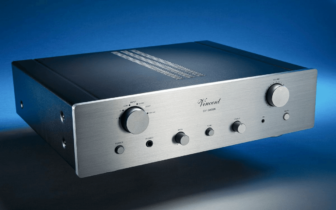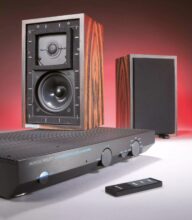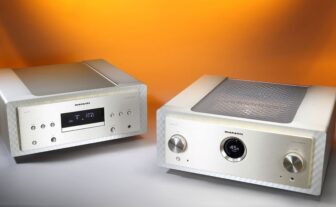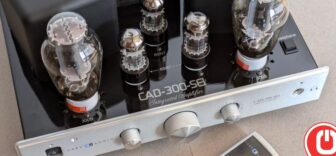McIntosh MA5300 AC Integrated Amplifier Review
A McIntosh is more than just an amplifier. It stands for top-notch American manufacturing—like the fully equipped “little integrated” MA5300 AC for $7,850. It will either win you over immediately, or you might feel you’ve missed something special.
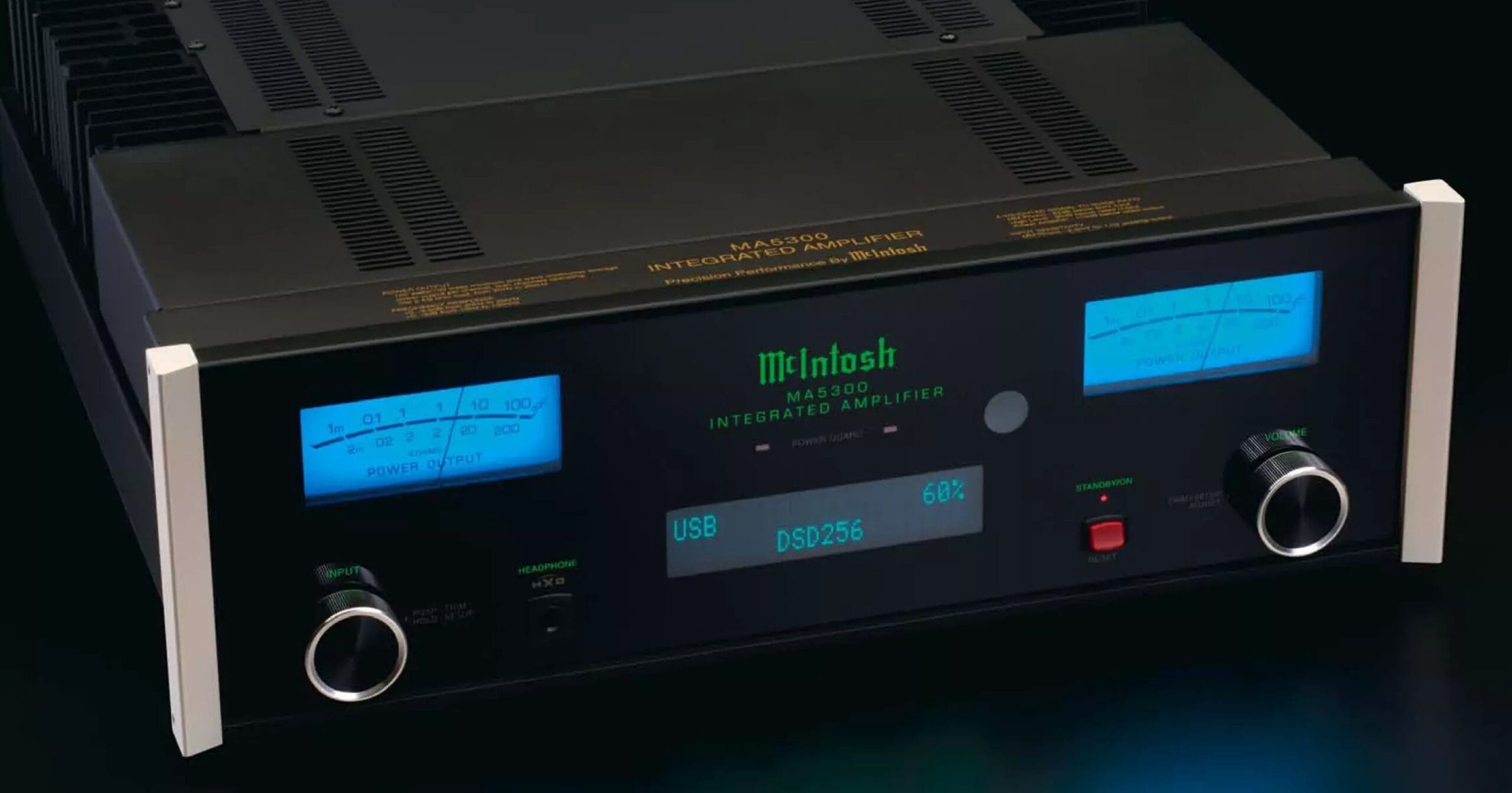
In the United States, things are often bigger. For the author, this isn’t just a saying but a fact. Our test model proves it: The 17.2 kg MA5300 AC is actually the starting point (!) of McIntosh Laboratory Incorporated’s amplifier lineup in Binghamton, New York. If the soul group Earth, Wind & Fire knew about it, they’d likely shout “Mighty Mighty.”
Iconic McIntosh Design
The look of a McIntosh amp has long been considered iconic. The German importer, Audio Components, used to display Harley-Davidson motorcycles alongside these American amps at trade shows—and not without reason. In a rapidly changing world, the “McIntosh look” with its signature black glass front and blue-lit watt meters offers a warm, familiar touch. It creates an emotional bond with the product, as a perceptive colleague once said.
While the exterior still uses the tried-and-true blend of matte aluminum, black paint (instead of anodizing), and glass, the MA5300 AC also has important technical updates “under the hood.”
New High-Quality Digital Board
The biggest change from the earlier MA5200 AC is the DA1 Digital Audio Module, which had been available only in higher-end models. Since it’s a plug-in module, McIntosh owners can upgrade later with a more advanced version. At the moment, the MA5300 AC’s DAC uses an 8-channel, 32-bit converter in “Quad Balanced” mode (type: ES9016). It’s the second-highest model in the popular ESS Technology Sabre series.
This remote-controlled McIntosh has four digital inputs (two coaxial, two optical). Its USB input supports high-resolution signals up to 32-bit/384 kHz and handles DSD256 and DXD 384 kHz streams. It also includes a special MCT port for high-resolution digital signals from McIntosh SACD transports. Finally, it offers five analog inputs (one balanced, four unbalanced), plus an MM phono input.
Built in unbalanced Class A/B, the MA5300 AC uses modern high-current output transistors that are carefully managed for bias and temperature, so it’s ready to deliver its best sound right when you power it on. Warm-up is unnecessary. Plus, thanks to its large cooling fins, this amp barely heats up, even at full output, which helps reduce the stress on electronic parts. McIntosh calls it “Cool Running,” and the author sees it as a sustainable benefit.
The McIntosh delivers its full sonic capabilities right when you switch it on.
As a “smaller integrated,” the MA5300 AC doesn’t use an output transformer. That’s a feature of the larger models.
Typically, an output transformer adjusts the amplifier’s output to match the speakers. It makes sure power is sent efficiently to the speakers. In our test model, though, the signals are sent directly (“direct coupled”) in the output stage.
To protect the speakers, this “Mac” features a “Power Guard” circuit that constantly compares the input and output signals. If the amp is pushed beyond its limits, Power Guard steps in to prevent damage.
A special highlight is the amp’s headphone output. It uses a 6.35 mm jack and a “Headphone Crossfeed Director” (HDX) circuit. This design makes headphone listening feel more like listening through speakers, reducing far left/right separation and creating more of a “front-stage” experience. Listening tests with both the high-impedance Sennheiser HD 800 S and the low-impedance Beyerdynamic T5 p confirmed it works well.
Complex Yet Intuitive Controls
Before discussing how it sounds, let’s consider the MA5300 AC’s interface and build quality. After a short adjustment period, the reviewer found the extensive settings—using two front-mounted aluminum knobs—straightforward and smooth. The left knob changes inputs and, when pressed (“Push Trim”), lets you adjust balance, treble, bass, and other basic settings. It also accesses less common commands like “Home Cinema Pass Through” (“Hold Setup”). The right knob is for volume and navigating whatever you selected on the left knob.
Except for possibly a bit of softness in how the buttons/knobs are mounted, this review unit was otherwise flawless and felt very solid.
All measurements on the McIntosh were also flawless, whether from the built-in DAC, the MM phono stage, the headphone output, or the power amp section.
Enjoyable Sound
We had a few questions when we began our listening tests. We wanted to see not only how the “Mac” sounded in general but also how the bundled power cord, built-in DAC, and MM phono module performed.
For the sonic evaluation, we used both the excellent Mission 770 two-way monitor and the $45,000 T+A Solitaire S 540. The “reference speaker” is quite demanding, considering efficiency, impedance curve, range, and deep bass. The American amp handled it well, although it finally hit its volume limits. Our source was the Technics SL-G700M2 multi-player, streaming high-res audio via Chromecast and Tidal.
In general, the MA5300 AC’s sound can be summed up in three positive traits: confident, expressive, and velvety. We also noticed the McIntosh sounded slightly gentler than the similarly priced Luxman L-550AXII we used for comparison. This didn’t mean it sweetened the sound; the McIntosh was too lively for that.
The MA5300 AC’s sound especially highlights three strengths: confidence, expressiveness, and warmth.
Vocals and brass instruments came across with wonderful clarity and liveliness. For example, the gentle dialog of wind instruments in the second movement of Mozart’s Piano Concerto No. 17, performed by Philippe Entremont with the Collegium Musicum of Paris (Sony), really stood out. The McIntosh seemed to add a special energy and nuance to even the briefest silence between notes.
Great for Imperfect Recordings
Because of its full midrange, warm tone, and rich color presentation—especially its vivid midrange—the amp worked beautifully for older, less-than-perfect recordings. One such test was Beethoven’s cello sonatas, played by Pablo Casals and Rudolf Serkin (Sony). The recording from the Prades Festival in 1953 obviously isn’t modern, and there are audience and background sounds.
Still, none of that mattered; even for a critical hi-fi reviewer, you were simply immersed in the music. The writer was captivated by the passionate expression of Casals and Serkin and, at that moment, wouldn’t have chosen a studio recording instead. The reviewer couldn’t give a better compliment.
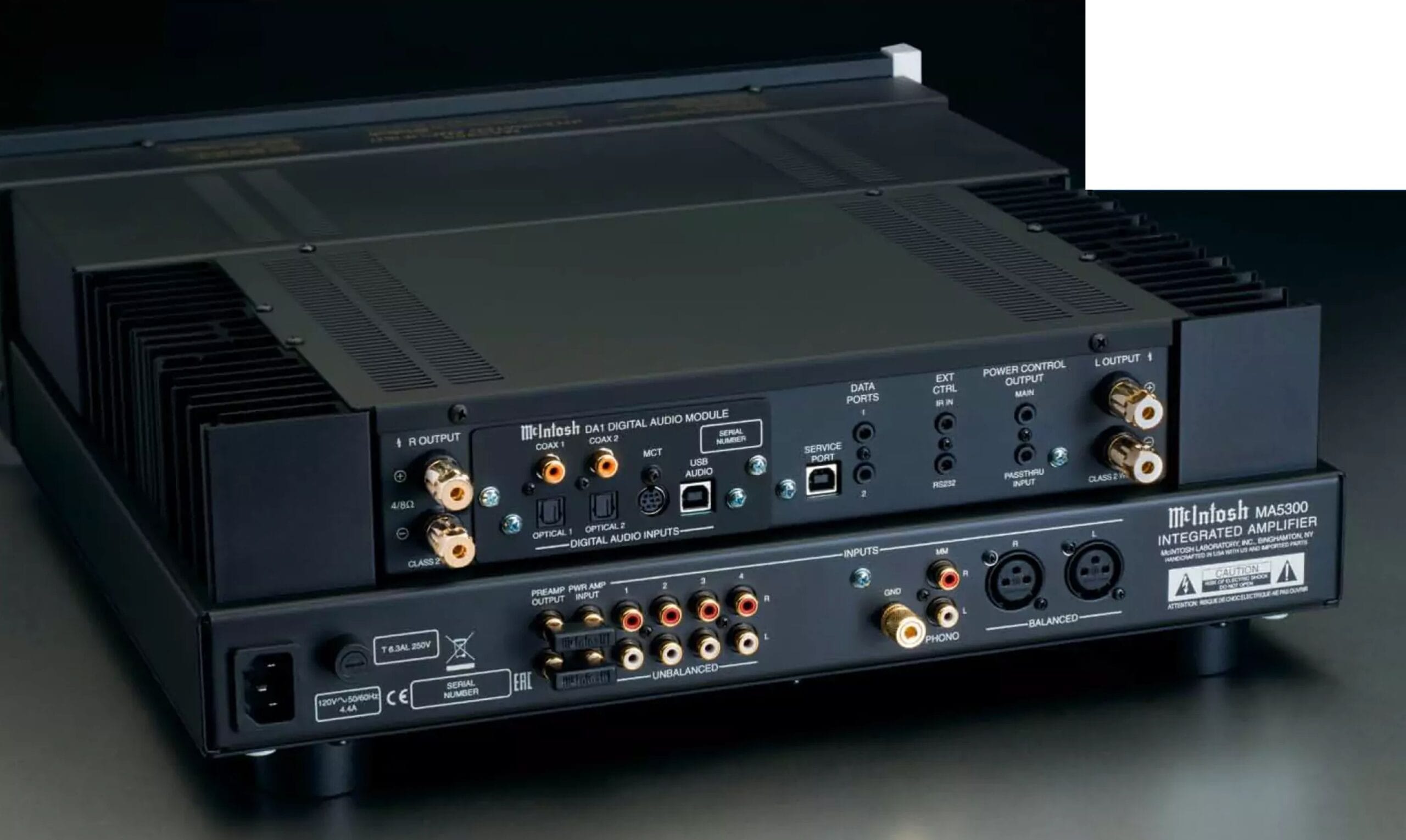
The large cooling fins on the rear sides stay almost cool to the touch, even under high load.
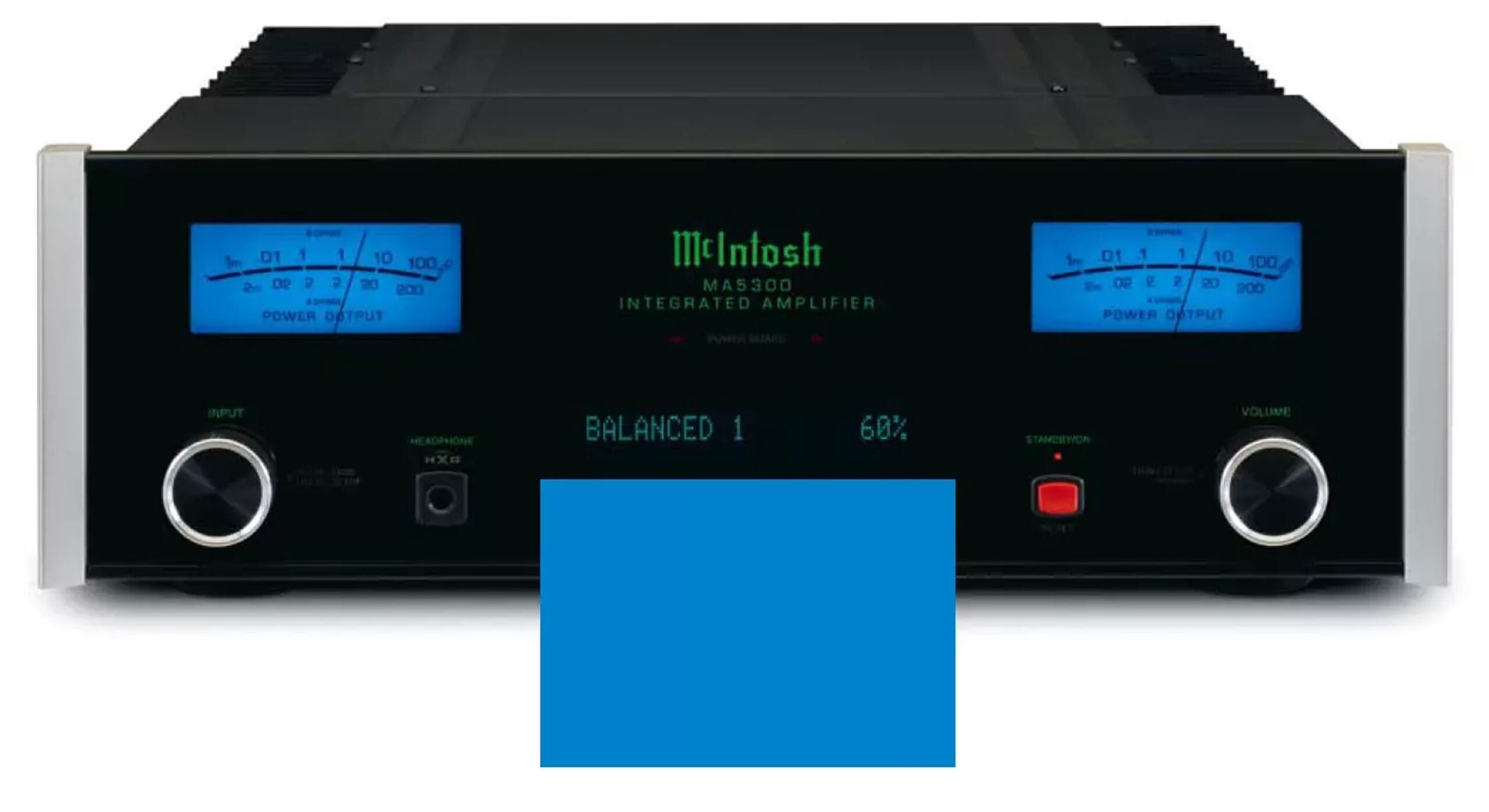
This small display clearly shows which input is selected, the volume, and current tone settings.
With the included high-end Shunyata Venom HC v2 power cable (which alone costs $495), the McIntosh felt slightly fuller and firmer in the lower registers. The overall sound seemed more organized, and the treble was better integrated. These are slight but meaningful improvements.
Moving on to the phono input: The reviewer remembers older McIntosh models where the MM input seemed more like an afterthought. That’s definitely not the case with the MA5300 AC. Its MM input sounded clean, tonally accurate, and above all energetic. Records came across as involving as high-resolution streams. Superb!
The McIntosh’s built-in DAC also excelled. It went head-to-head against the Technics player’s DAC—which is a tough comparison, since the MA5300 AC is primarily an amplifier (though it aims to be the centerpiece of a stereo or home theater system by packing a lot of technology into one chassis).
Back to the McIntosh DAC: It gave a bit less punch, body, and spaciousness than the Technics. Yet in the higher frequencies, it was highly impressive. The mysterious, atmospheric opening track “Minature” from America’s Holiday (Warner) album sounded gorgeous—very detailed, colorful, and delicate. You could also hear great tonal shades and a wonderful forward drive on “Tin Man,” the next track.
In conclusion, the MA5300 AC might be McIntosh’s “entry-level” integrated amplifier, but it offers nearly everything that makes a true “Mac” special: extensive features, everyday usability, excellent craftsmanship, high resale value, and, above all, a sound that delivers warmth without losing detail or overhyping anything. It always adds life to the music—just as you’d expect from a dream-worthy American amplifier.
Measurement Diagrams
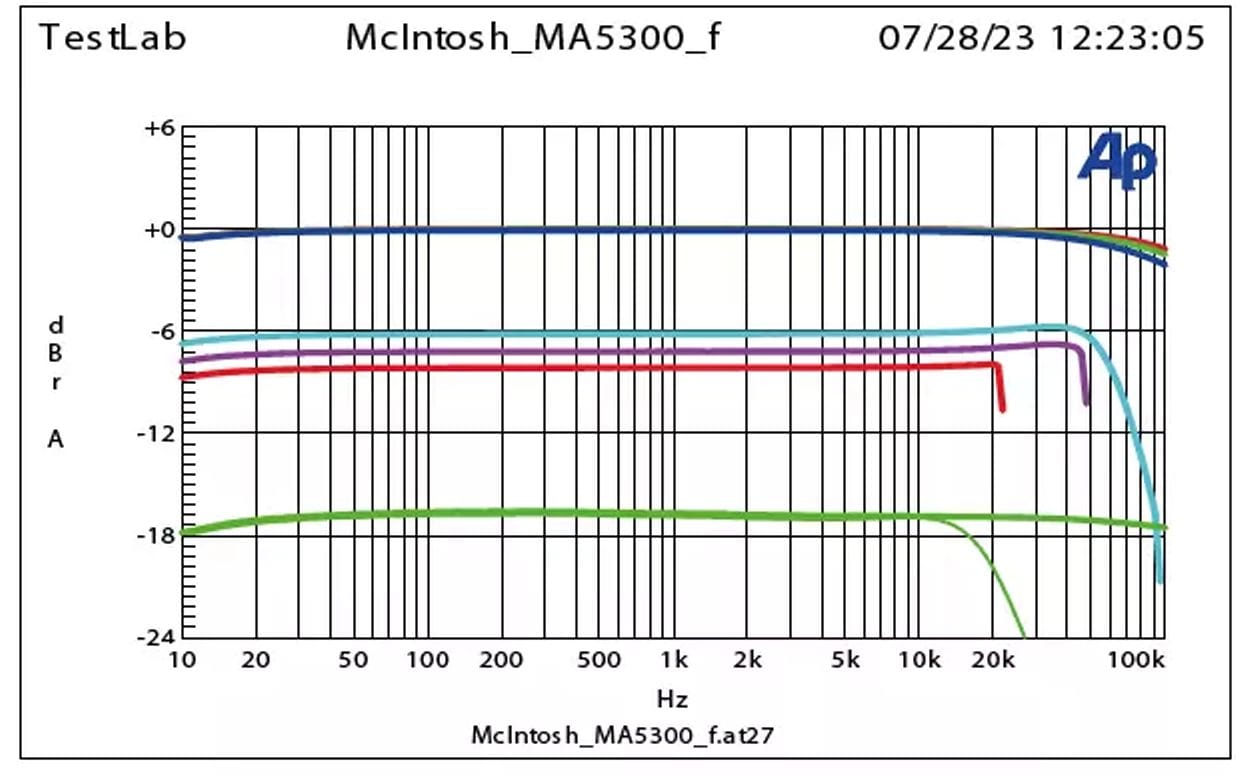
Frequency Response
Linear and stable (top), slight subsonic filtering, plus clean measurements for digital (middle) and phono inputs
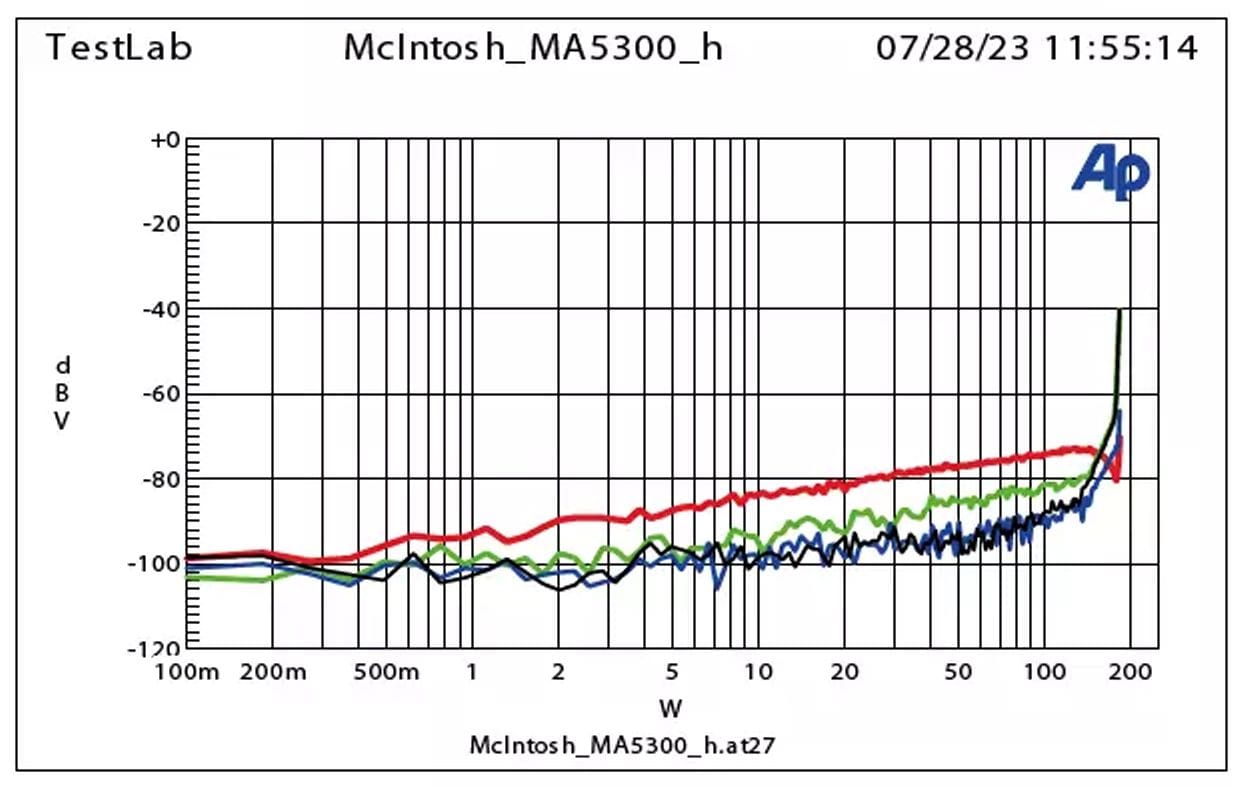
Distortion Analysis k2 to k5 vs. Power
Extremely low distortion, k2 (red) is consistently the main harmonic, THD+N at 1 W = 0.015%
Practice and Compatibility
Amplifier Compatibility Diagram
“Very powerful and stable under load, with power loss only on very low-impedance speakers (< 2 Ω).”
- Voltage at 8 Ω: 32.0 V
- Frequency Response: 0.1 dB
- Current at 3 Ω: 7.3 A
Measurements
- Sine Power (1 kHz, k = 1%)
• at 8 Ω: 120 W
• at 4 Ω: 189 W - Music Power (60 Hz Burst)
• at 8 Ω: 128 W
• at 4 Ω: 208 W - Signal‑to‑Noise Ratio
• Line (RCA/XLR/Digital, 10 V measured): 98/98/98 dB
• Phono MM/with cartridge (10 V measured): 83/78 dB - Power Consumption (Standby/Operation): – / 31 W
Ratings
- Measurements: 8/10
- Practical Performance: 9/10
- Build Quality: 9/10
Sound (Analog/Streaming/USB): 8.6/10
Overall Rating: → 8.6/10
Price/Performance: outstanding



